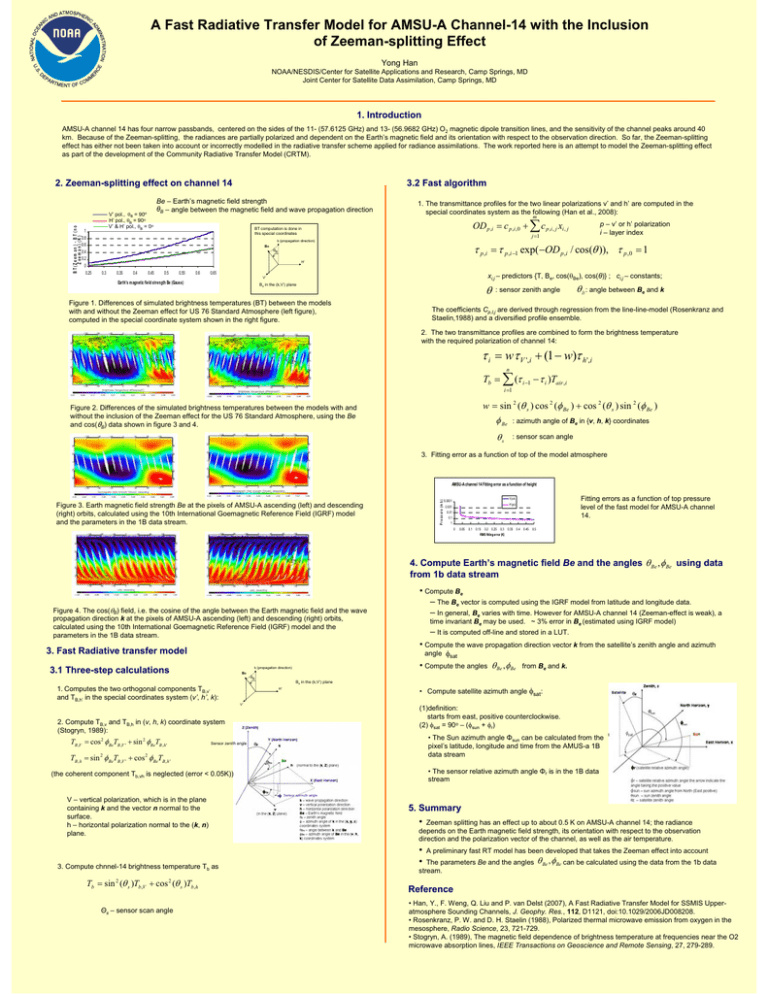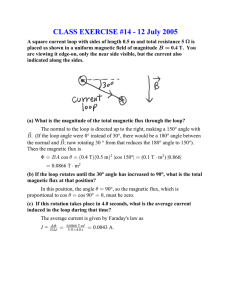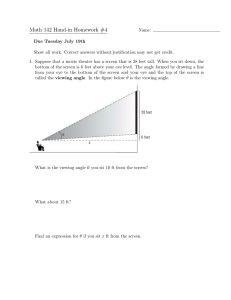A Fast Radiative Transfer Model for AMSU-A Channel-14 with the... of Zeeman-splitting Effect
advertisement

A Fast Radiative Transfer Model for AMSU-A Channel-14 with the Inclusion
of Zeeman-splitting Effect
Yong Han
NOAA/NESDIS/Center for Satellite Applications and Research, Camp Springs, MD
Joint Center for Satellite Data Assimilation, Camp Springs, MD
D
ER
S.
CE
U.
EP
AR
TME
O
NT OF C
MM
1. Introduction
AMSU-A channel 14 has four narrow passbands, centered on the sides of the 11- (57.6125 GHz) and 13- (56.9682 GHz) O2 magnetic dipole transition lines, and the sensitivity of the channel peaks around 40
km. Because of the Zeeman-splitting, the radiances are partially polarized and dependent on the Earth’s magnetic field and its orientation with respect to the observation direction. So far, the Zeeman-splitting
effect has either not been taken into account or incorrectly modelled in the radiative transfer scheme applied for radiance assimilations. The work reported here is an attempt to model the Zeeman-splitting effect
as part of the development of the Community Radiative Transfer Model (CRTM).
B T (Z ee m an ) - B T (n o
Z ee m an ) (K )
2. Zeeman-splitting effect on channel 14
1
0.8
0.6
0.4
0.2
0
0.25
V’ pol., θB = 90o
H’ pol., θB = 90o
V’ & H’ pol., θB = 0o
3.2 Fast algorithm
Be – Earth’s magnetic field strength
θB – angle between the magnetic field and wave propagation direction
1. The transmittance profiles for the two linear polarizations v’ and h’ are computed in the
special coordinates system as the following (Han et al., 2008):
m
OD p ,i = c p ,i ,0 + ∑ c p ,i , j xi , j
BT computation is done in
this special coordinates
Be
p – v’ or h’ polarization
i – layer index
j =1
k (propagation direction)
τ p ,i = τ p ,i −1 exp(−OD p ,i / cos(θ )), τ p , 0 = 1
θB
H’
0.3
0.35
0.4
0.45
0.5
0.55
0.6
0.65
xi,j – predictors {T, Be, cos(θBe), cos(θ)} ; ci,j – constants;
V’
Earth's magnetic field strength Be (Gauss)
θ
Be in the (k,V’) plane
Figure 1. Differences of simulated brightness temperatures (BT) between the models
with and without the Zeeman effect for US 76 Standard Atmosphere (left figure),
computed in the special coordinate system shown in the right figure.
: sensor zenith angle
θB : angle between Be and k
The coefficients Cp,I,j are derived through regression from the line-line-model (Rosenkranz and
Staelin,1988) and a diversified profile ensemble.
2. The two transmittance profiles are combined to form the brightness temperature
with the required polarization of channel 14:
τ i = wτ V ',i + (1 − w)τ h ',i
n
Tb = ∑ (τ i −1 − τ i )Tair ,i
i =1
w = sin 2 (θ s ) cos 2 (φ Be ) + cos 2 (θ s ) sin 2 (φ Be )
φ Be : azimuth angle of Be in {v, h, k} coordinates
Figure 2. Differences of the simulated brightness temperatures between the models with and
without the inclusion of the Zeeman effect for the US 76 Standard Atmosphere, using the Be
and cos(θB) data shown in figure 3 and 4.
θs
: sensor scan angle
3. Fitting error as a function of top of the model atmosphere
AMSU-A channel 14 Fitting error as a function of height
P r e s s u r e (m b )
NATIONAL OC
EA
D ATMOSPHER
AN
IC
TRATION
NIS
MI
AD
C
NI
Figure 3. Earth magnetic field strength Be at the pixels of AMSU-A ascending (left) and descending
(right) orbits, calculated using the 10th International Goemagnetic Reference Field (IGRF) model
and the parameters in the 1B data stream.
Fitting errors as a function of top pressure
level of the fast model for AMSU-A channel
14.
V pol.
0.0001
H pol
0.001
0.01
0.1
1
0
0.05
0.1 0.15 0.2 0.25 0.3 0.35 0.4 0.45 0.5
RMS fitting error (K)
4. Compute Earth’s magnetic field Be and the angles θ Be , φ Be using data
from 1b data stream
Figure 4. The cos(θB) field, i.e. the cosine of the angle between the Earth magnetic field and the wave
propagation direction k at the pixels of AMSU-A ascending (left) and descending (right) orbits,
calculated using the 10th International Goemagnetic Reference Field (IGRF) model and the
parameters in the 1B data stream.
3. Fast Radiative transfer model
time invariant Be may be used. ~ 3% error in Be (estimated using IGRF model)
– It is computed off-line and stored in a LUT.
• Compute the wave propagation direction vector k from the satellite’s zenith angle and azimuth
angle φsat
• Compute the angles θ Be , φBe
k (propagation direction)
3.1 Three-step calculations
Be
1. Computes the two orthogonal components TB,v’
and TB,h’ in the special coordinates system (v’, h’, k):
θB
• Compute satellite azimuth angle φsat:
H’
(1)definition:
starts from east, positive counterclockwise.
(2) φsat = 90o – (φsun + φr)
2. Compute TB,v and TB,h in (v, h, k) coordinate system
(Stogryn, 1989):
• The Sun azimuth angle Φsun can be calculated from the
pixel’s latitude, longitude and time from the AMUS-a 1B
data stream
Sensor zenith angle
TB , h = sin φBeTB ,V ' + cos φ BeTB ,h '
2
2
• The sensor relative azimuth angle Φr is in the 1B data
stream
(the coherent component Tb,vh is neglected (error < 0.05K))
V – vertical polarization, which is in the plane
containing k and the vector n normal to the
surface.
h – horizontal polarization normal to the (k, n)
plane.
3. Compute chnnel-14 brightness temperature Tb as
Tb = sin (θ s )Tb ,V + cos (θ s )Tb, h
2
from Be and k.
Be in the (k,V’) plane
V’
TB ,V = cos 2 φBeTB ,V ' + sin 2 φBeTB ,h '
• Compute Be
– The Be vector is computed using the IGRF model from latitude and longitude data.
– In general, Be varies with time. However for AMSU-A channel 14 (Zeeman-effect is weak), a
Sensor azimuth angle
5. Summary
• Zeeman splitting has an effect up to about 0.5 K on AMSU-A channel 14; the radiance
depends on the Earth magnetic field strength, its orientation with respect to the observation
direction and the polarization vector of the channel, as well as the air temperature.
•
•
A preliminary fast RT model has been developed that takes the Zeeman effect into account
The parameters Be and the angles
stream.
θ Be , φBe can be calculated using the data from the 1b data
2
Θs – sensor scan angle
Reference
• Han, Y., F. Weng, Q. Liu and P. van Delst (2007), A Fast Radiative Transfer Model for SSMIS Upperatmosphere Sounding Channels, J. Geophy. Res., 112, D1121, doi:10.1029/2006JD008208.
• Rosenkranz, P. W. and D. H. Staelin (1988), Polarized thermal microwave emission from oxygen in the
mesosphere, Radio Science, 23, 721-729.
• Stogryn, A. (1989), The magnetic field dependence of brightness temperature at frequencies near the O2
microwave absorption lines, IEEE Transactions on Geoscience and Remote Sensing, 27, 279-289.






